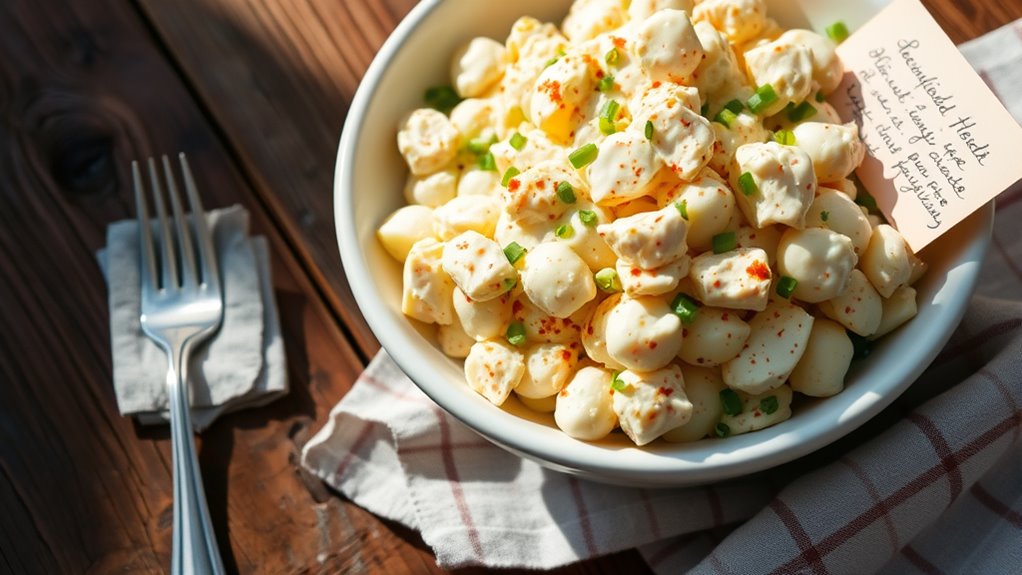A classic grandmother’s potato salad comes together with sturdy waxy potatoes, creamy mayonnaise, chopped hard-boiled eggs, and crunchy pickles. Use Yukon or red potatoes, boiled until just tender, then cool briefly to keep texture intact. Peel eggs, dice veggies, and fold in gradually with seasonings like salt, pepper, mustard, and a splash of vinegar. Chill briefly to set the structure, then toss again for even coating. If you keep going, you’ll pick up extra tips and tweaks.
Ingredients and Quantity
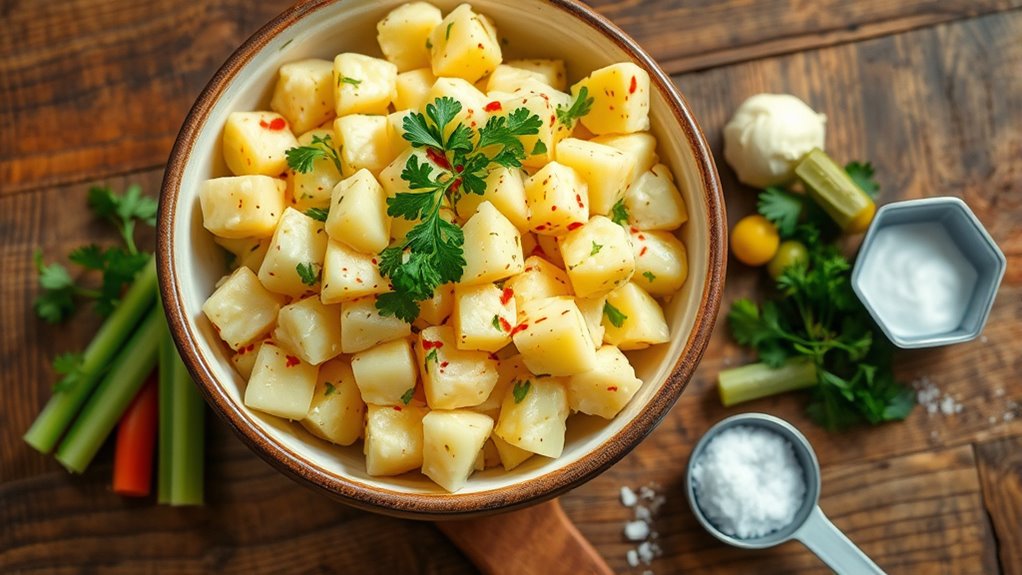
The ingredients you’ll need for this potato salad are straightforward: waxy potatoes (about 2 pounds), hard-boiled eggs (4), celery (2 stalks), red onion (1 small), dill pickles (4 to 6), mayonnaise (¾ to 1 cup), yellow mustard (1–2 tablespoons), white vinegar (1–2 tablespoons), salt, and pepper.
Here’s a compact guide to quantities and options:
| Item | Quantity | Notes |
|---|---|---|
| Potatoes | 2 lb | Waxy varieties work best |
| Eggs | 4 | Hard-boiled, peeled |
| Add-ins | 2–3 cups | Veggies, pickles |
| Seasoning | to taste | Salt, pepper, mustard, vinegar |
Potato varieties influence texture and flavor; seasoning options let you tailor brightness and balance for freedom-loving cooks.
Preparations
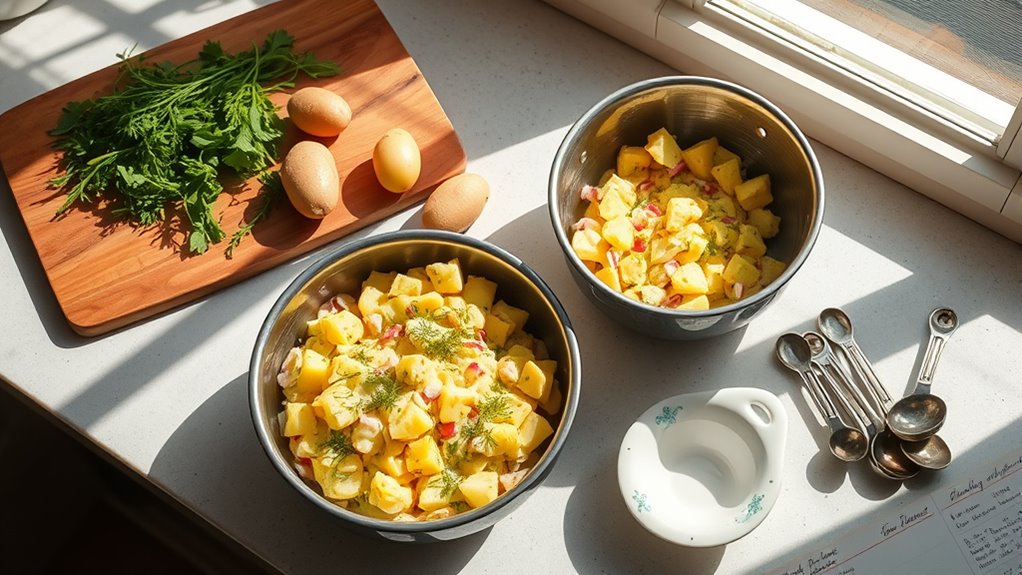
To prepare this potato salad, start by selecting your potatoes and eggs, then cook them so their textures remain distinct and creamy. You’ll use evidence-based steps: choose Yukon or red potatoes for sturdy texture, boil until just tender, and hard-cook eggs for clean slicing. Preparation methods should emphasize gentle handling to preserve color and moisture. Cool potatoes briefly before mixing to avoid a mushy result, and peel eggs when convenient to guarantee clean surfaces. Ingredient sourcing matters: opt for fresh, locally sourced produce when possible, and verify egg freshness from a trusted supplier. Taste and adjust with a light dressing of mayo, mustard, and a touch of vinaigrette to balance richness. Maintain clean, precise technique and enjoy a flexible, satisfying result.
Kitchen tools or Kitchenware Required
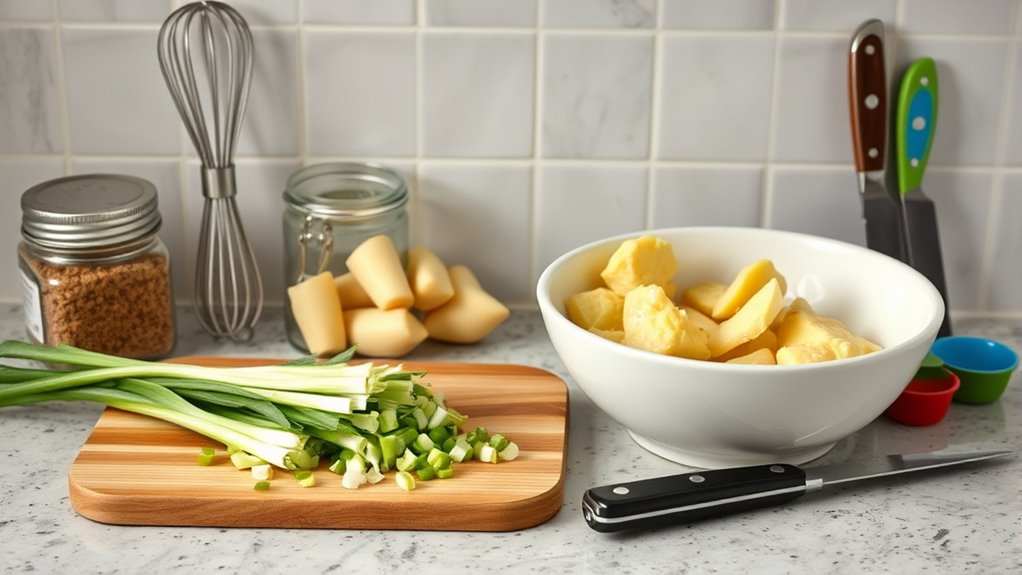
You’ll want a few reliable tools that support the gentle handling and precise timing this recipe requires: a medium pot for boiling potatoes, a separate pot or steamer basket for eggs, a sharp chef’s knife and a sturdy cutting board, and a large mixing bowl for folding everything together without mashing.
Table imagery:
| Tools you’ll use | Why it matters |
|---|---|
| Kitchen gadgets | Provide efficiency and control |
| Essential utensils | Guarantee consistent results |
These items are practical, evidence-based choices that support confident, free-flowing cooking. Select durable, easy-to-clean pieces, prioritizing balance, grip, and stability. With the right kitchen gadgets and essential utensils, you’ll maintain potato integrity while you prep add-ins, dressings, and textures. This approach minimizes mishaps, reduces waste, and aligns with your desire for freedom in the kitchen.
How to Cook

- Boil the potatoes until they are just tender enough to slide a fork in with little resistance.
- Drain and cool the potatoes long enough to handle without collapsing.
- Apply precise cooking techniques to preserve texture and balance flavors.
- Fold in seasonings gradually for reliable flavor enhancements.
- Check doneness with a fork, not a timer, and adjust heat to maintain a gentle simmer.
- Toss warm potatoes with a light dressing to permeate without breaking edges.
- Taste and adjust salt, acidity, and sweetness in small increments.
- Chill briefly to set the structure, then re-toss for even coating.
How to Serve
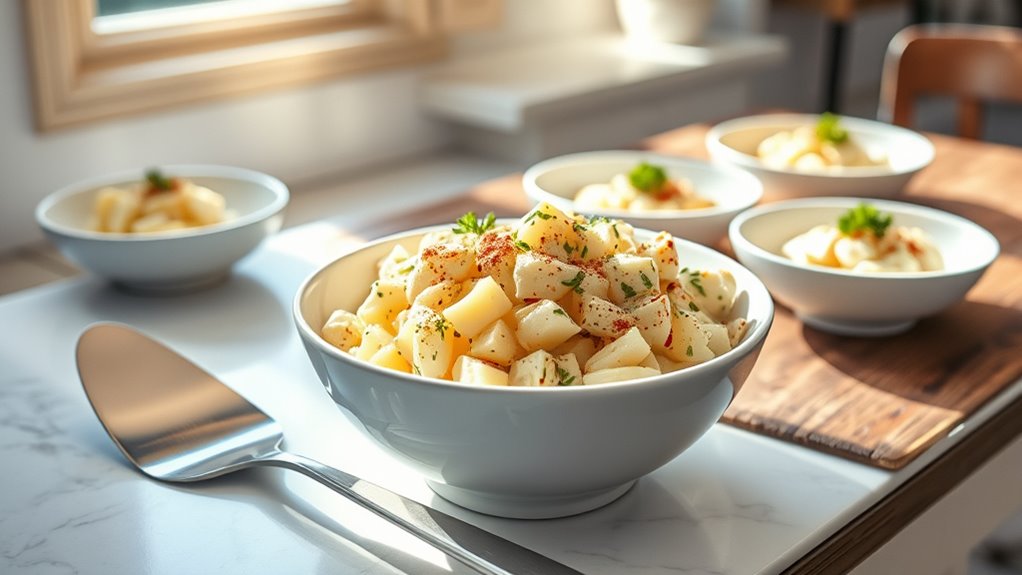
After preparing the potato salad, the way you serve it can influence texture and flavor retention. You should plate it promptly, using a clean, temperature-stable surface to maintain mayonnaise binding and potato integrity. For best results, portion with a wide spatula to minimize breaking, then garnish lightly with chopped herbs or a dusting of paprika for aroma without overpowering the potatoes. Serving suggestions emphasize even distribution of mix-ins so every bite is balanced. Let the dish rest briefly to meld flavors, but avoid overcrowding the plate, which can dampen texture. Presentation ideas include offering in a shallow dish with a central mound, or in individual bowls for a casual gathering. Keep it simple, practical, and inviting. Freedom in dining starts with thoughtful, restrained execution.
Tips
Tip 4: Start with the right balance of mayo and seasoning. You’ll appreciate precise ratios and taste testing as you assemble. For best texture and flavor, weigh ingredients, then adjust with small increments. Use evidence-based guidance: fresh mayo, light sour, and minimal mayo-to-potato ratio maintain structure without greasiness. Flavor enhancements come from bold, compatible add-ins that don’t overwhelm the dish. Focus on balance, not complexity, to keep freedom in your kitchen.
- Measure mayo and yogurt for creaminess, then adjust with lemon juice or vinegar.
- Add salt, pepper, and a touch of sugar or mustard to heighten brightness.
- Fold in chopped celery, onion, and dill for texture and aroma.
- Serve with crusty bread or greens for pleasing flavor enhancements and versatile serving suggestions.
Food Value and Benefit
Potato salad offers a nutritious and practical dish that combines energy, essential vitamins, and minerals with satisfying flavors.
Food Value of Potato Salad:
- Provides complex carbohydrates and dietary fiber from potatoes, supporting sustained energy and digestive health.
- Contains fats from mayo-based dressing, contributing to satiety and enhancing flavor.
- Includes micronutrients such as vitamin C, potassium, and resistant starch from potatoes.
- Additional ingredients like onions, herbs, and mustard increase micronutrient content without adding excess sugars.
Benefits of Eating Potato Salad:
- Supports digestive health and blood sugar stability due to resistant starch and fiber.
- Supplies vitamin C, which aids immune function and skin health.
- Provides potassium, essential for maintaining healthy blood pressure and muscle function.
- Offers energy-dense fats from mayo that help in nutrient absorption and prolonged fullness.
- Enhances overall nutrient intake when paired with vegetables and consumed in mindful portions.
Enjoying potato salad with balanced ingredients and appropriate serving sizes allows you to meet daily nutritional needs while savoring a flavorful and satisfying dish.
Frequently Asked Questions
How Long Can You Store Leftovers Safely?
Leftovers stay safe for 3–4 days in the fridge. You should store them in shallow containers, label dates, and reheat to 165°F. Storage tips: refrigerate promptly; leftovers safety hinges on cooling quickly and proper covering.
Can It Be Made Dairy-Free for Lactose Intolerance?
Yes, you can make it dairy-free. Use dairy alternatives like lactose-free mayo or olive-oil mayo, and add dairy-free yogurt if 원하는. For Lactose free options, choose plant-based mayo; dairy alternatives work well and taste great.
What Can Replace Mayo in the Dressing?
Seeking a mayo substitute? Go with Greek yogurt or avocado puree. You’ll get creaminess, tang, and dairy-free texture while keeping the dressing evidence-based, precise, practical, and freedom-loving in flavor and approach.
Is It Gluten-Free, and Are There Hidden Gluten Ingredients?
Yes, it’s gluten-free if you avoid gluten-containing add-ins; watch for hidden gluten. Use gluten substitutes like mayo alternatives, and prevent cross contamination by clean utensils and separate prep surfaces for safe, evidence-based, practical freedom.
Can I Freeze the Potato Salad After Making It?
Yes, you can freeze it. For best results, use Freezing Tips: freeze soon after making it, portion thinly, and seal well. Expect Texture Changes; potato quality may degrade, so thaw gently and use within 1–2 months.
